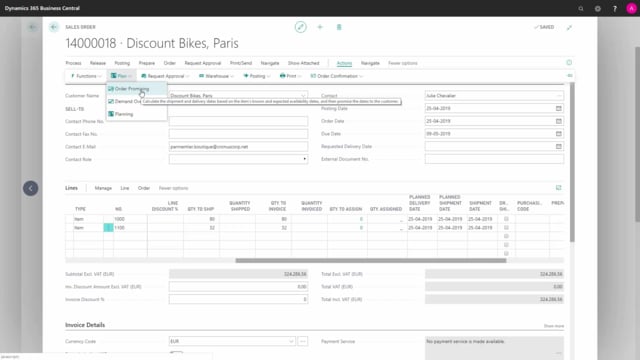
How to do sales order promising with ATP and CTP in Business Central?
When I enter sales orders in Business Central, as a salesperson, and the items are not available on inventory, I will get some notification in the header of the item, that it’s not available.
This is what happens in the video
And maybe I want to calculate when is it possible for us to ship this item to the customer.
Therefore, we have different functionalities for this, for instance, the available to promise and capable to promise.
I’ve created two lines here with some quantities and I know that they’re both out of stock and not available.
And the dates out here are the 25th of April.
Now, from my action menu in the plan action, I can go into order promising.
In the order promising, we have those two different possibilities of the advanced calculation, whereas the demand overview and planning actions, to more simple handling of creating purchase orders and production orders.
In my order promising overview, I can calculate available to promise or capable to promise.
Calculating available to promise will calculate, including the available orders or all the orders in my system already, and all my existing demand and supply.
So when I calculated the available to promise, my bike should be able to ship on May 24 and the front wheel on April 30.
So that takes into account everything that is already in other orders and stocks and and everything.
And it takes into account the expected lead time to produce this item on a top level.
That’s the available to promise, and it has a nice description on the, if you mouse over on the menu, to see what it’s actually doing.
I need to close it to refresh the dates, I’ll go into it again on the order promising, whereas the capable to promise, and you can see when I click that it’s calculating a little more, it’s actually calculating, what if analysis so it’s assuming that we have no items and no orders in stock, so we have to produce all of it.
So if you assume that everything in your books already and then your orders is planned for something else, and this should be quite new thing you have, to produce from the bottom of.
You can use the capable to promise and you can see the dates are quite further ahead, because it’s assuming you need to buy all the raw materials etc.
So capable to promise, and it’s also set in the menu, is more like a what if scenario.
With those two functions you can calculate, what is possible with the existing routings and bill of materials and hierarchies in the system.

